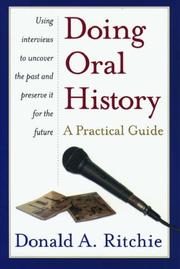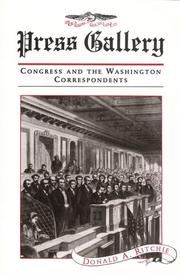| Listing 1 - 5 of 5 |
Sort by
|

ISBN: 1280564040 1423774086 9781423774082 9781280564048 0195099079 9780195099072 9786610564040 6610564043 9780195328370 9780198025948 0198025947 Year: 1997 Publisher: New York Oxford University Press
Abstract | Keywords | Export | Availability | Bookmark
 Loading...
Loading...Choose an application
- Reference Manager
- EndNote
- RefWorks (Direct export to RefWorks)
Sixty essays on American news reporters, editors, publishers, and broadcasters, including Benjamin Franklin, Frederick Douglass, and Connie Chung, whose careers significantly advanced or symbolized major changes in journalism.
Journalists --- Journalism & Communications --- Journalism --- Biography --- Juvenile literature

ISBN: 9780198035138 0198035136 0195154347 0195154339 9780195154337 0195154339 9780195154344 0195154347 1280837799 9781280837791 Year: 2003 Publisher: Oxford Oxford University Press
Abstract | Keywords | Export | Availability | Bookmark
 Loading...
Loading...Choose an application
- Reference Manager
- EndNote
- RefWorks (Direct export to RefWorks)
Oral history is vital to our understanding of the cultures and experiences of the past. Unlike written history, oral history forever captures people's feelings, expressions, and nuances of language. But what exactly is oral history? How reliable is the information gathered by oral history? And what does it take to become an oral historian? Donald A. Ritchie, a leading expert in the field, answers these questions and in particular, explains the principles and guidelines created by the Oral History Association to ensure the professional standards of oral historians. Doing Oral History has become
Oral history. --- Oral history --- Historiography. --- Historical criticism --- History --- Authorship --- Oral biography --- Oral tradition --- Methodology. --- Criticism --- Historiography --- Methodology

ISBN: 9780674703766 9780674703758 0674703758 9780674703759 0674703766 9780674042780 0674042786 Year: 1991 Publisher: Cambridge, MA : Harvard University Press,
Abstract | Keywords | Export | Availability | Bookmark
 Loading...
Loading...Choose an application
- Reference Manager
- EndNote
- RefWorks (Direct export to RefWorks)
'Press Gallery' examines the lives of Greeley, Horace White, Ben"" Perley Poore, Emily Briggs, Jane Grey Swisshelm, James G. Blaine, and others who were positioned in the hub of government when the Civil War, the purchase of Alaska, the Credit Mobilier scandal, and the Johnson impeachment hearings were making front-page news.
Journalists --- Press and politics --- Politics and the press --- Press --- Advertising, Political --- Government and the press --- Journalism --- Columnists --- Commentators --- Authors --- History. --- Political aspects --- United States. --- Reporters and reporting --- Washington (D.C.) --- Politics and government. --- Politics --- Reporting --- By --- News media. --- History
Book
ISBN: 0199329354 0199395195 0199329346 9780199329342 9780199329335 0199329338 9780199395194 Year: 2015 Publisher: New York, NY
Abstract | Keywords | Export | Availability | Bookmark
 Loading...
Loading...Choose an application
- Reference Manager
- EndNote
- RefWorks (Direct export to RefWorks)
Doing Oral History is considered the premier guidebook to oral history, used by professional oral historians, public historians, archivists, and genealogists as a core text in college courses and throughout the public history community. Over the past decades, the development of digital audio and video recording technology has continued to alter the practice of oral history, making it even easier to produce quality recordings and to disseminate them on the Internet. This basic manual offers detailed advice on setting up an oral history project, conducting interviews, making video recordings, preserving oral history collections in archives and libraries, and teaching and presenting oral history. Using the existing Q&A format, the third edition asks new questions and augments previous answers with new material, particularly in these areas: 1. Technology: As before, the book avoids recommending specific equipment, but weighs the merits of the types of technology available for audio and video recording, transcription, preservation, and dissemination. Information about web sites is expanded, and more discussion is provided about how other oral history projects have posted their interviews online. 2. Teaching: The new edition addresses the use of oral history in online teaching. It also expands the discussion of Institutional Review Boards (IRBs) with the latest information about compliance issues. 3. Presentation: Once interviews have been conducted, there are many opportunities for creative presentation. There is much new material available on innovative forms of presentation developed over the last decade, including interpretive dance and other public performances. 4. Legal considerations: The recent Boston College case, in which the courts have ruled that Irish police should have access to sealed oral history transcripts, has re-focused attention on the problems of protecting donor restrictions. The new edition offers case studies from the past decade. 5. Theory and Memory: As a beginner's manual, Doing Oral History has not dealt extensively with theoretical issues, on the grounds that these emerge best from practice. But the third edition includes the latest thinking about memory and provides a sample of some of the theoretical issues surrounding oral sources. It will include examples of increased studies into catastrophe and trauma, and the special considerations these have generated for interviewers. 6. Internationalism: Perhaps the biggest development in the past decade has been the spreading of oral history around the world, facilitated in part by the International Oral History Association. New oral history projects have developed in areas that have undergone social and political upheavals, where the traditional archives reflect the old regimes, particularly in Eastern Europe, the Middle East, Asia, Africa, and Latin America. The third edition includes many more references to non-U.S. projects that will still be relevant to an American audience. These changes make the third edition of Doing Oral History an even more useful tool for beginners, teachers, archivists, and all those oral history managers who have inherited older collections that must be converted to the latest technology.
Oral history. --- Oral history --- Historiography. --- Methodology. --- HISTORY / Modern / General. --- HISTORY / Reference. --- HISTORY / Social History.
Book
ISBN: 0813182476 Year: 2022 Publisher: Lexington : University Press of Kentucky,
Abstract | Keywords | Export | Availability | Bookmark
 Loading...
Loading...Choose an application
- Reference Manager
- EndNote
- RefWorks (Direct export to RefWorks)
This fascinating story of Elizabeth 'Bess' Clements Abell (1933-2020) offers a window into Abell's life as former social secretary to President Johnson, as well as an insider's view of social life in the nation's capital during the tumultuous 1960s.
Presidents --- Social secretaries --- Staff --- Abell, Bess Clements, --- Johnson, Lady Bird, --- Johnson, Lyndon B. --- Friends and associates. --- United States. --- Officials and employees. --- Washington (D.C.) --- Kentucky --- Social life and customs
| Listing 1 - 5 of 5 |
Sort by
|

 Search
Search Feedback
Feedback About UniCat
About UniCat  Help
Help News
News